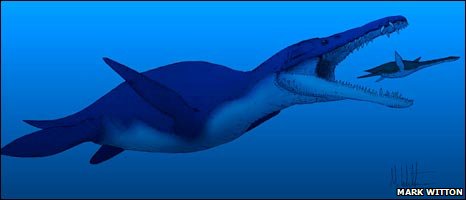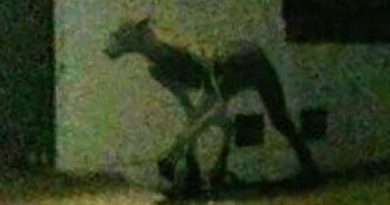Colossal ‘sea monster’ unearthed
Source : http://news.bbc.co.uk/earth/hi/earth_news/newsid_8322000/8322629.stm
The fossilised skull of a colossal “sea monster” has been unearthed along the UK’s Jurassic Coast. The ferocious predator, which is called a pliosaur, terrorised the oceans 150 million years ago. The skull is 2.4m long, and experts say it could belong to one of the largest pliosaurs ever found: measuring up to 16m in length.
The fossil, which was found by a local collector, has been purchased by Dorset County Council. It was bought with money from the Heritage Lottery Fund, and it will now be scientifically analysed, prepared and then put on public display at Dorset County Museum.Palaeontologist Richard Forrest told the BBC: “I had heard rumours that something big was turning up. But seeing this thing in the flesh, so to speak, is just jaw dropping. It is simply enormous.”
Pliosaurs were a form of plesiosaur, a group of giant aquatic reptiles that dominated the seas around the same time that dinosaurs roamed the Earth. They had short necks and huge, crocodilian-like heads that contained immensely powerful jaws and a set of huge, razor-sharp teeth. Using four paddle-like limbs to propel their bulky bodies through the water, they made easy work of passing prey such as dolphin-like ichthyosaurs and even other plesiosaurs.
David Martill, a palaeontologist from the University of Portsmouth, said: “These creatures were monsters.
“They had massive big muscles on their necks, and you would have imagined that they would bite into the animal and get a good grip, and then with these massive neck muscles they probably would have thrashed the animals around and torn chunks off. “It would have been a bit of a blood bath.”
Big contender
Experts think this latest discovery could represent one of the largest pliosaurs ever found. Dr Martill said: “This thing is absolutely enormous. When I saw it, it really just hit me how big it was.” The fossil comprises a lower jaw and upper skull.
And based on their length of 2.4m (7.9ft), it is estimated that the creature would have measured between 10 and 16m (33-52ft) from tip to tail, and would have weighed in at a hefty 7-12 tonnes.
This means it could rival recent finds made in Svalbard, where beasts dubbed “The Monster” and “Predator X” were thought to have measured 15m-long (49ft), and in Mexico, where the “Monster of Aramberri” was discovered in 2002, and is believed to have been of similar dimensions. Dr Martill added: “We only have the head, so you cannot be absolutely precise. “But it may be vying with the ones found in Svalbard and Mexico for the title of the world’s largest.”
The specimen is still in its rocky, unprepared form, but it is clear that it has been remarkably well preserved.
Richard Forrest, a plesiosaur expert, said: “Pliosaur skulls are very big, but not that robust, in general, and you tend to find them crushed flat – completely ‘pancaked’.
“What is fantastic about this new skull, not only is it absolutely enormous, but it is pretty much in 3D and not much distorted.”He added: “You have this wonderful lower jaw – and you can just see from the depth and the thickness that this was immensely strong. “It could have taken a human in one gulp; in fact, something like a T. Rex would have been breakfast for a beast like this.”
Geological treasure trove
The fossil was discovered by a local collector along the Jurassic Coast, a 150km (95 mile) stretch of coastline covering Dorset and East Devon that spans 185 million years of geological history.
The exact location of the find is not being revealed, as Dorset County Council does not want to encourage people to head to the spot. The area is unstable and prone to rock falls and landslides.
Richard Edmonds, Dorset County Council’s earth science manager for the Jurassic Coast, said: “This part of the coastline is eroding really rapidly and that means the fossils that are trapped and buried are constantly tumbling out on to the beach. “The collector was lucky enough to come along on the day a large piece fell out of the cliff, and that gave him the clue to keep on looking. He spent the next four years coming back day after day, and as a result he has uncovered this absolutely incredible fossil.
“It was an amazing effort.”
Dr Edmonds believes that the rest of the giant may still be entombed in the rock, but it could take decades for it to emerge. He said: “The ground is dipping very steeply, and as it is such a huge specimen it will be buried beneath layer-upon-layer of rock, so we will have to patiently wait for the next big landslide.”
Read complete story at http://news.bbc.co.uk/earth/hi/earth_news/newsid_8322000/8322629.stm



